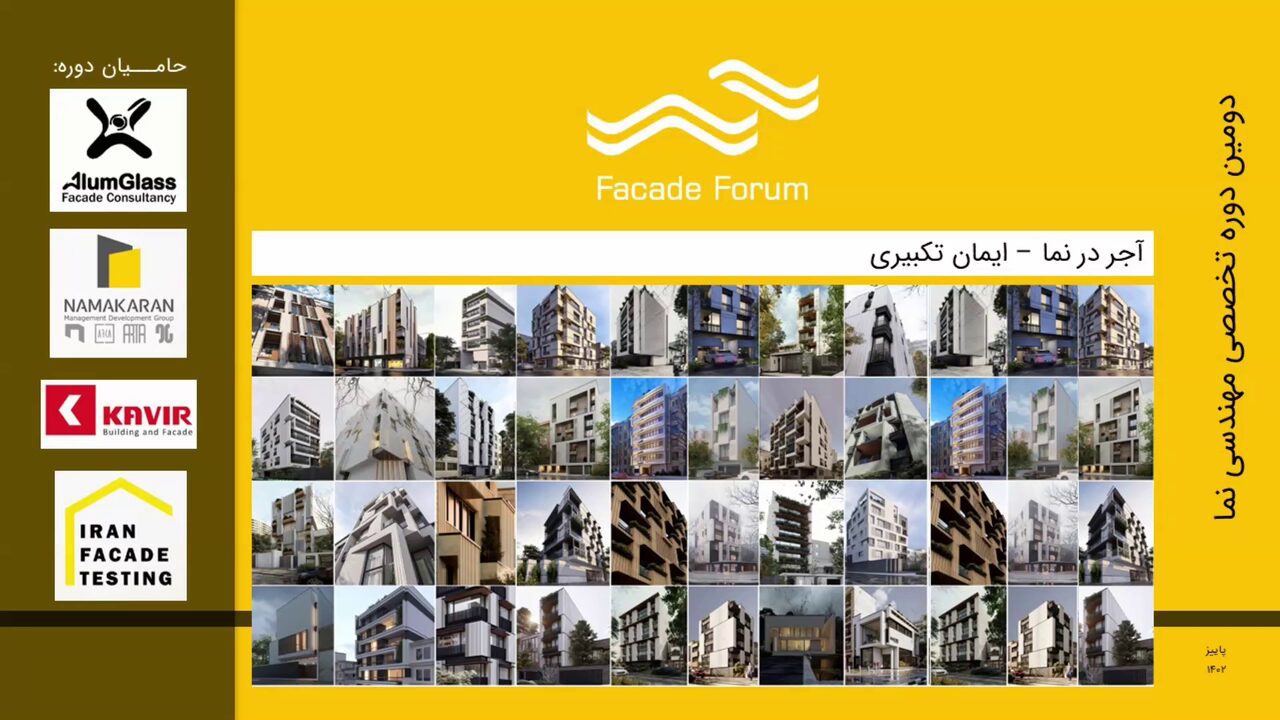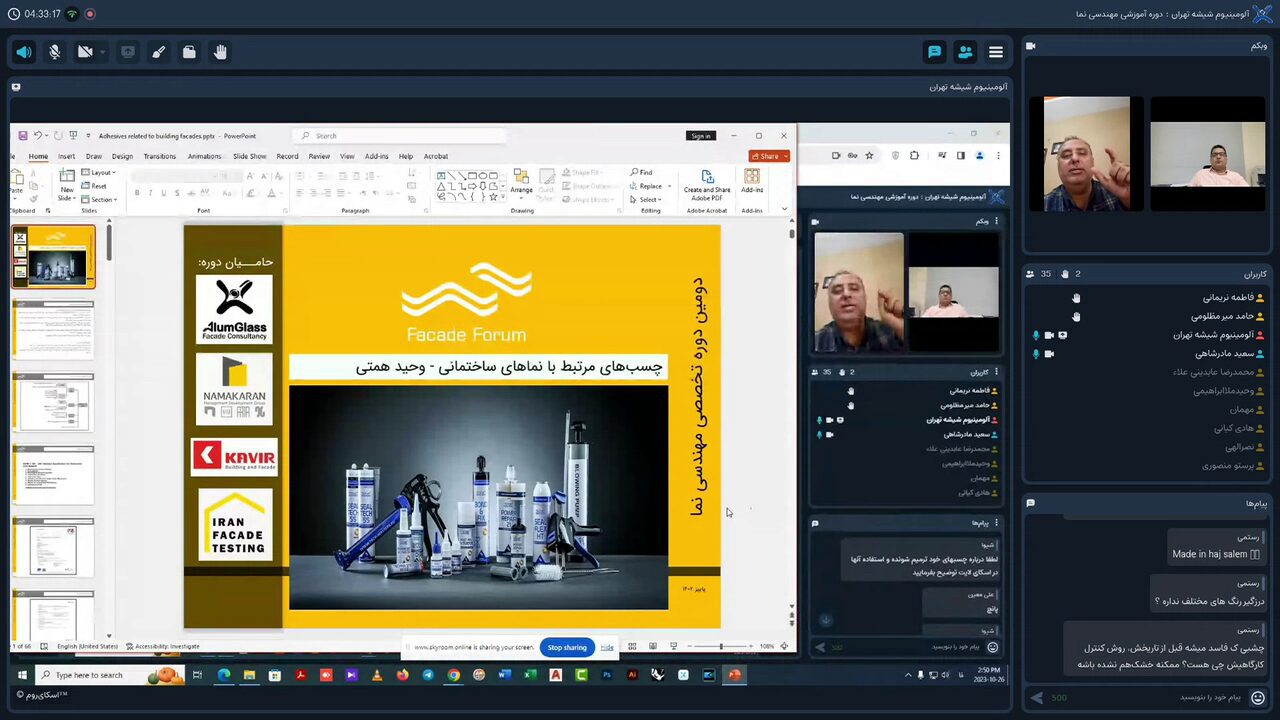جذابیت جاودانه آجر در معماری: بینشی از ایمان تکبیری
معرفی
استفاده از آجر در معماری دارای سابقه ای غنی است که نمادی از دوام و جذابیت زیبایی است. معمار ایرانی ایمان تکبیری، در سخنرانی خود در FacadeForum، با استفاده از تجربه گسترده خود در پروژه های ساختمان شهری، به نکات ظریف استفاده از آجر در ساخت و سازهای مدرن می پردازد.
اهمیت تاریخی آجر
آجر برای هزاران سال یک عنصر اساسی در ساخت و ساز بوده است. تکبیری بر اهمیت تاریخی آنها تأکید میکند و یادآور میشود که چگونه تمدنهای باستانی از آجر نه تنها برای عملکرد، بلکه برای پتانسیل تزئینیشان نیز استفاده میکردند.
آجر در معماری مدرن
در گذار به دوران معاصر، تکبیری به انطباق استفاده از آجر در معماری مدرن می پردازد. او نشان می دهد که چگونه آجرها می توانند زیبایی شناسی سنتی را با الزامات طراحی مدرن ترکیب کنند و آنها را به انتخابی همه کاره برای معماران امروزی تبدیل کنند.
جنبه های فنی کار با آجر
تکبیری نگاهی دقیق به ملاحظات فنی هنگام کار با آجر ارائه می دهد. این شامل انتخاب نوع مناسب آجر، درک قابلیتهای باربری آنها و روشهای نوآورانه آجرچینی است که میتواند یکپارچگی سازه را افزایش دهد.
ملاحظات زیبایی شناختی اجر
تطبیق پذیری زیباشناختی آجرها موضوع اصلی سخنرانی تکبیری است. او بررسی میکند که چگونه میتوان از بافتها و رنگهای مختلف آجر برای ایجاد جلوههای بصری منحصربهفرد استفاده کرد که طراحی معماری را بهبود میبخشد.
پایداری و آجر
یکی از جنبه های مهم معماری مدرن، پایداری است. تکبیری به این موضوع میپردازد که چگونه آجرها به دلیل خواص حرارتی خود به بهرهوری انرژی در ساختمانها کمک میکنند و آنها را به انتخابی پایدار در مواجهه با چالشهای زیستمحیطی جهانی تبدیل میکنند.
مطالعات موردی: پروژه های آجری موفق
تکبیری با نشان دادن نکات خود، چندین مطالعه موردی را به اشتراک میگذارد که در آنها از آجرها برای دستیابی به اهداف زیباییشناختی و عملکردی به طور مؤثر استفاده شده است. این مثالهای واقعی، دیدگاهی عملی در مورد مفاهیم نظری مورد بحث ارائه میدهند.
چالش های کار با آجر
تکبیری علیرغم مزایایی که دارند، از بحث در مورد چالش هایی که معماران هنگام کار با آجر با آن روبرو هستند ابایی ندارد. این شامل مسائل مربوط به وزن، هزینه و مهارت مورد نیاز برای نصب صحیح است.
نوآوری در ساخت آجر
پیشرفتهای فناوری بر تولید آجر تأثیر گذاشته است، نکتهای که تکبیری عمیقاً به آن میپردازد. او به این موضوع می پردازد که چگونه تکنیک های مدرن آجر را بادوام تر و سازگارتر با شرایط مختلف آب و هوایی کرده است.
آینده آجر در معماری
با نگاهی به آینده، تکبیری در مورد نقش آجر در آینده در معماری حدس می زند. او پیشنهاد می کند که نوآوری های مداوم در طراحی و علم مواد احتمالاً کاربردهای آجر را گسترش می دهد.
نتیجه
تکبیری در پایان بر ارزش ماندگار آجر در معماری تاکید می کند. او معماران را تشویق می کند تا به کاوش در پتانسیل آجر برای ترکیب سنت با نوآوری ادامه دهند و از ارتباط آنها در طراحی معماری آینده اطمینان حاصل کنند.
سوالات متداول در مورد آجر در معماری
1. چه چیزی آجر را به یک انتخاب پایدار در ساخت و ساز تبدیل می کند؟
آجرها دارای خواص حرارتی عالی هستند که بازده انرژی در ساختمان ها را بهبود می بخشد، هزینه های گرمایش و سرمایش را کاهش می دهد و به پایداری کمک می کند.
2. آجر در ساختمان های بلند قابل استفاده است؟
بله، آجرها را می توان در سازه های بلندمرتبه استفاده کرد، به ویژه هنگامی که با تکنیک های سازه ای مدرن ترکیب می شود که قابلیت تحمل بار آنها را افزایش می دهد.
3. نوآوری های مدرن چگونه بر تولید آجر تأثیر می گذارد؟
پیشرفت های تکنولوژی منجر به توسعه آجرهایی شده است که از نظر اندازه یکنواخت تر، بادوام تر و سازگارتر با شرایط مختلف محیطی هستند.
4. مزایای زیبایی شناختی استفاده از آجر در معماری چیست؟
آجرها طیف وسیعی از بافت ها و رنگ ها را ارائه می دهند که به معماران این امکان را می دهد که طرح های منحصر به فرد و از نظر بصری جذابی ایجاد کنند که می تواند مکمل زیبایی شناسی سنتی و مدرن باشد.
5. چالش های اصلی هنگام کار با آجر چیست؟
چالشها شامل مدیریت وزن آجر در سازههای بزرگ، اطمینان از نصب ماهرانه برای جلوگیری از مشکلات ساختاری، و هزینههای مرتبط با مصالح آجری با کیفیت بالا است.

The Timeless Charm of Bricks in Architecture: Insights from Iman Takbiri
Introduction
The use of bricks in architecture has a rich history, symbolizing durability and aesthetic appeal. Iranian architect Iman Takbiri, in his lecture at FacadeForum, delves into the nuances of using bricks in modern construction, drawing on his extensive experience in urban building projects.
The Historical Significance of Bricks
Bricks have been a fundamental element in construction for millennia. Takbiri emphasizes their historical importance, noting how ancient civilizations utilized bricks not only for their functionality but also for their decorative potential.
Bricks in Modern Architecture
Transitioning to contemporary times, Takbiri discusses the adaptation of brick use in modern architecture. He highlights how bricks can blend traditional aesthetics with modern design requirements, making them a versatile choice for today’s architects.
Technical Aspects of Working with Bricks
Takbiri provides a detailed look at the technical considerations when working with bricks. This includes the selection of the right type of bricks, understanding their load-bearing capabilities, and the innovative methods of brick laying that can enhance structural integrity.
Aesthetic Considerations
The aesthetic versatility of bricks is a central theme in Takbiri’s lecture. He explores how different textures and colors of bricks can be used to create unique visual effects that enhance the architectural design.
Sustainability and Bricks
An important aspect of modern architecture is sustainability. Takbiri touches on how bricks contribute to energy efficiency in buildings due to their thermal properties, making them a sustainable choice in the face of global environmental challenges.
Case Studies: Successful Brick Projects
Illustrating his points, Takbiri shares several case studies where bricks have been effectively used to achieve both aesthetic and functional goals. These real-life examples provide a practical perspective on the theoretical concepts discussed.
Challenges in Working with Bricks
Despite their advantages, Takbiri does not shy away from discussing the challenges architects face when working with bricks. This includes issues related to weight, cost, and the skill required for proper installation.
Innovations in Brick Manufacturing
Advancements in technology have impacted brick manufacturing, a point Takbiri explores in depth. He discusses how modern techniques have made bricks more durable and adaptable to various climatic conditions.
Future of Bricks in Architecture
Looking ahead, Takbiri speculates on the future role of bricks in architecture. He suggests that ongoing innovations in design and material science will likely expand the applications of bricks.
Conclusion
Takbiri concludes by reaffirming the enduring value of bricks in architecture. He encourages architects to continue exploring the potential of bricks to combine tradition with innovation, ensuring their relevance in the future of architectural design.
FAQs about Bricks in Architecture
1. What makes bricks a sustainable choice in construction?
Bricks have excellent thermal properties that improve energy efficiency in buildings, reducing heating and cooling costs and contributing to sustainability.
2. Can bricks be used in high-rise buildings?
Yes, bricks can be used in high-rise constructions, especially when combined with modern structural techniques that enhance their load-bearing capabilities.
3. How do modern innovations affect brick manufacturing?
Technological advancements have led to the development of bricks that are more uniform in size, more durable, and adaptable to various environmental conditions.
4. What are the aesthetic advantages of using bricks in architecture?
Bricks offer a range of textures and colors, allowing architects to create unique and visually appealing designs that can complement both traditional and modern aesthetics.
5. What are the main challenges when working with bricks?
Challenges include managing the weight of bricks in large structures, ensuring skilled installation to avoid structural issues, and the cost associated with high-quality brick materials.






